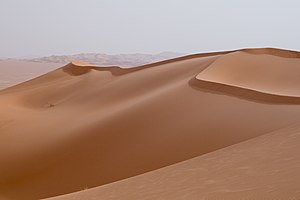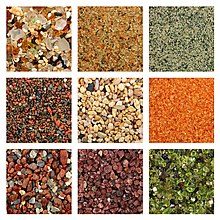

glass, dune, quartz,
volcanic, biogenic coral, pink coral,
volcanic, garnet, olivine.
Samples are from the Gobi Desert, Estonia, Hawaii and the mainland United States. (1×1 cm each)[1]
Sand is a granular material composed of finely divided mineral particles. Sand has various compositions but is defined by its grain size. Sand grains are smaller than gravel and coarser than silt. Sand can also refer to a textural class of soil or soil type; i.e., a soil containing more than 85 percent sand-sized particles by mass.[2]
The composition of sand varies, depending on the local rock sources and conditions, but the most common constituent of sand in inland continental settings and non-tropical coastal settings is silica (silicon dioxide, or SiO2), usually in the form of quartz.
Calcium carbonate is the second most common type of sand. One such example of this is aragonite, which has been created over the past 500 million years by various forms of life, such as coral and shellfish. It is the primary form of sand apparent in areas where reefs have dominated the ecosystem for millions of years, as in the Caribbean. Somewhat more rarely, sand may be composed of calcium sulfate, such as gypsum and selenite, as is found in places such as White Sands National Park and Salt Plains National Wildlife Refuge in the U.S.
Sand is a non-renewable resource over human timescales, and sand suitable for making concrete is in high demand.[3] Desert sand, although plentiful, is not suitable for concrete. Fifty billion tons of beach sand and fossil sand are used each year for construction.[4]
- ^ Siim Sepp. "Sand types". sandatlas.org. Archived from the original on 13 August 2019. Retrieved 17 February 2020.
- ^ Glossary of terms in soil science (PDF). Ottawa: Agriculture Canada. 1976. p. 35. ISBN 978-0662015338. Archived (PDF) from the original on 14 February 2019. Retrieved 11 August 2014.
- ^ Constable, Harriet (3 September 2017). "How the demand for sand is killing rivers". BBC News Magazine. Archived from the original on 3 September 2017. Retrieved 9 September 2017.
- ^ Albarazi, Hannah. "The Slippery Slopes of the World Sand Shortage". Archived from the original on 29 March 2019. Retrieved 29 March 2019.